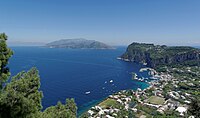Economy of Naples
Electronics and aircraft industries

Naples was once an important electronics industrial hub, however, many facilities such as the
was formed and maintained a presence in Naples, albeit smaller than its Aeritalia heyday.Shipbuilding
Ship construction yards are present in Naples city-proper, Pozzuoli, Castellammare di Stabia (motor yachts, fishing boats and fishing ships) as well as Castellammare di Stabia which is the site of a large shipyard, Cantieri Navali, owned by Fincantieri.
Food industry
Naples and its surroundings have a large number of small firms manufacturing canned vegetables, mostly tomato sauce. Family-sized pasta companies in Torre Annunziata collapsed around 1949-1950 due to the rise of industrial pasta makers in northern Italy. Only the traditional slow food, artisan-made pasta in Gragnano survived and remains one of the most famous traditional products of Naples. Fior di latte cheese is also made in the territories of Agerola, Lettere and Gragnano.
The wine industry is also prevalent in the Naples area, mainly in Gragnano, Lettere, Ercolano and Pozzuoli. Naples is known worldwide for Neapolitan coffee, made with the historical Neapolitan flip coffee pot which then led to the creation of the espresso coffee machine and Moka Express coffee pot. Some light industrial companies remain who roast coffee beans and produce ground coffee to be used with Neapolitan coffee machines.
Tourism


Tourism is one of the biggest sectors of the Neapolitan economy, with the hotel trade sector compromising 3.7% of Naples' GDP. Naples has always been and remains one of Italy's and Europe's top tourist city destinations, with the first tourists coming in the 18th century during the
Economic relevance

Measuring the economy on a provincial level, the
Akin to most developed countries and regions of the world, there has been a move away from a traditional agriculture-based economy in the wider province to one based on service industries.[5] In early 2002 there were over 249,590 enterprises operating in the province of Naples according to registrations in the Chamber of Commerce Public Register.[5] More than half of these are small enterprises with fewer than 20 workers; 70 companies are medium-sized with more than 200 workers; and 15 have more than 500 workers.[5] Employment in the province of Naples in different sectors breaks down as follows:[5]
Public services
|
Manufacturing | Commerce | Construction | Transportation | Financial services | Agriculture | Hotel trade | Other activities | |
|---|---|---|---|---|---|---|---|---|---|
| Percentage | 30.7% | 18% | 14% | 9.5% | 8.2% | 7.4% | 5.1% | 3.7% | 3.4% |
References
- ^ "City Mayors reviews the richest cities in the world in 2020". Citymayors.com. 2023-02-22.
- ^ a b "Site3-TGM table". Epp.eurostat.ec.europa.eu. Retrieved 2010-01-25.
- ^ "Euromonitor Internationals Top City Destinations Ranking > Euromonitor archive". Archived from the original on 2009-10-23.
- ^ Dossier Musei 2008 - Touring Club Italiano Archived 2009-02-06 at the Wayback Machine
- ^ a b c d e "Rapporto sullo stato dell'economia della Provincia di Napoli". Istituto ISSM. 2008-01-08. Archived from the original on 2011-09-27. Retrieved 2010-02-04.
- ^ "Lavoro: a Napoli disoccupazione al 28%". Intrage.it. 2008-01-08. Archived from the original on 2005-11-25.
